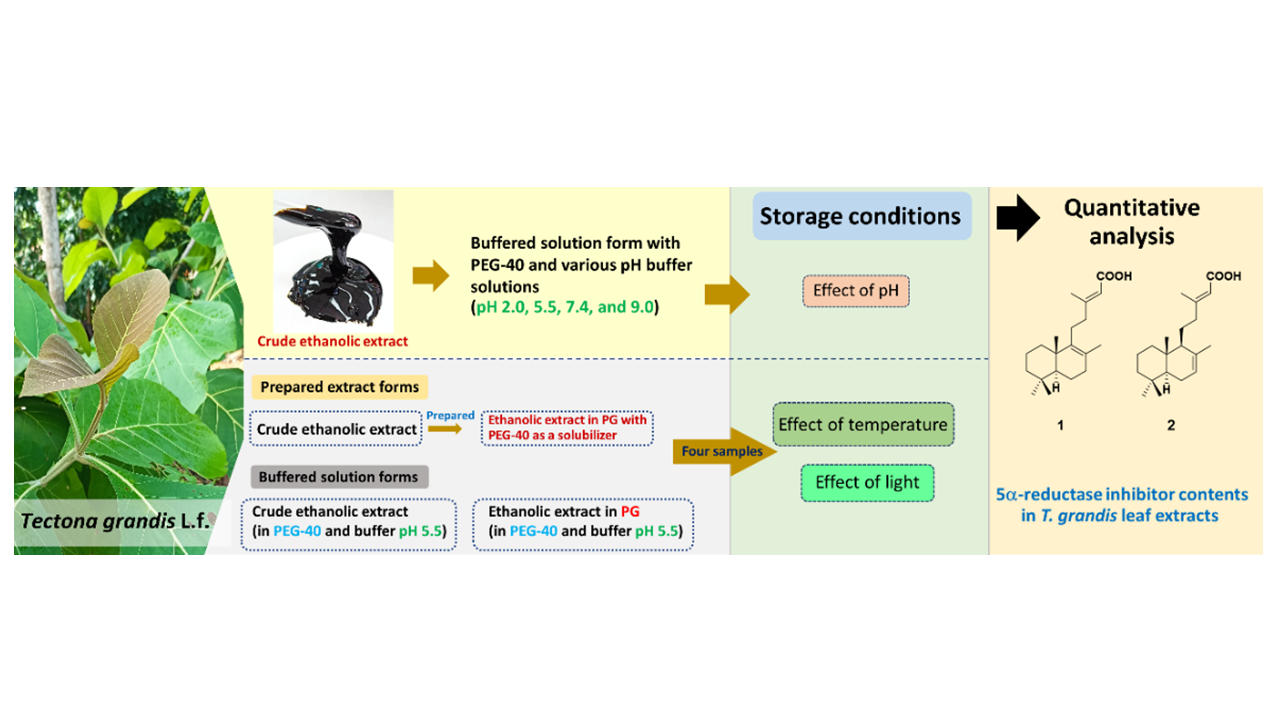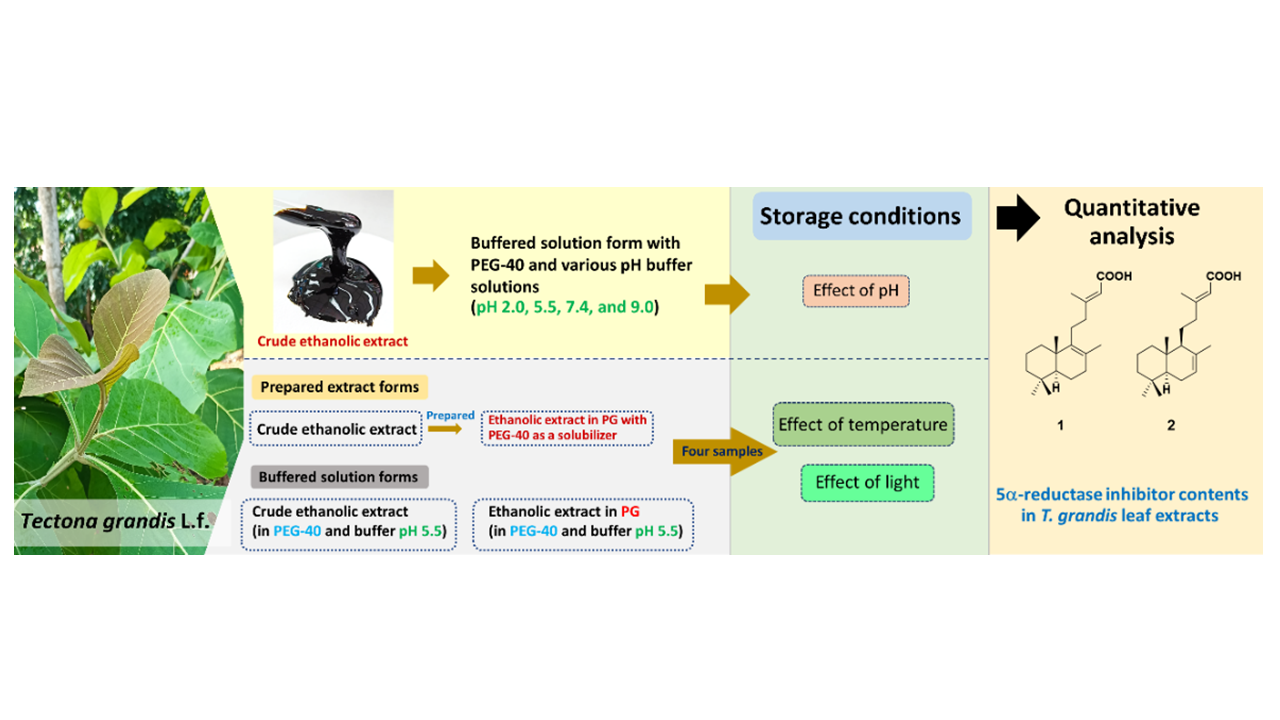Effects of Solvent System and Storage Condition on Chemical Stability of 5(alpha)-Reductase Inhibitor Compounds in Tectona grandis L.f. Leaf Extracts
DOI:
https://doi.org/10.48048/tis.2024.7339Keywords:
Tectona grandis, 5-Reductase inhibitor, Hair loss, Stability, Degradation, Shelf-lifeAbstract
Tectona grandis has been reported for its composition of two 5α-reductase inhibitors, specifically (+)-eperua-8,13-dien-15-oic acid (1) and (+)-eperua-7,13-dien-15-oic acid (2). These compounds exhibit potential as markers, enabling the standardization of leaf extracts during pre-formulation and formulation development. This study examined the effects of solvent system, pH, temperature and light on the stability of compounds 1 and 2 in the ethanolic extract and the ethanolic extract in PG with PEG-40 as a solubilizer. The remaining amount of the compounds at all test conditions was analyzed using HPLC. Compounds 1 and 2 exhibited greater stability in acidic solutions compared to neutral or basic environments. Their degradations were susceptible to light, particularly compound 1 of the ethanolic extract in PG. Both compounds in the solution form of the extract degraded rapidly at high temperature, whereas the present of PG minimized their degradation when the light was protected. According to the Q10 method, the calculated shelf-life of the extracts was 1.48 years. The extracts should be stored or prepared as a non-aqueous form or otherwise in a slightly acidic solution with appropriate light protection measures. The pre-formulation information obtained from this study holds significant value in informing the design and development of forthcoming anti-hair loss medications.
HIGHLIGHTS
- Stability assessment of 5α-reductase inhibitors in teak extracts with solubilizers
- Shelf life of 2 inhibitors in prepared extracts was predicted using Q10 method
- This data is useful for the design and development of future anti-hair loss drugs
GRAPHICAL ABSTRACT

Downloads
Metrics
References
CP Khare. Indian medicinal plants: An illustrated dictionary. Springer Berlin Heidelberg, New York, 2008.
P Vyas, DK Yadav and P Khandelwal. Tectona grandis (teak) - A review on its phytochemical and therapeutic potential. Nat. Prod. Res. 2019; 33, 2338-54.
N Nayeem and MD Karvekar. Anti microbial and anti-oxidant properties of the isolated compounds from the methanolic extract from the leaves of Tectona grandis. J. Basic Clin. Pharm. 2011; 2, 163-5.
TK Kopa, AT Tchinda, MF Tala, D Zofou, R Jumbam, HK Wabo, VPK Titanji, M Frédérich, NH Tan and P Tane. Antiplasmodial anthraquinones and hemisynthetic derivatives from the leaves of Tectona grandis (Verbenaceae). Phytochemistry Lett. 2014; 8, 41-5.
S Ramachandran, BR Kanth, A Rajasekaran and KTM Kumar. Evaluation of anti-inflammatory and analgesic potential of methanol extract of Tectona grandis flowers. Asian Pac. J. Trop. Biomed. 2011; 1, S155-S158.
PV Sharma and KC Samanta. Hypoglycemic activity of methanolic extract of Tectona grandis Linn. root in alloxan induced diabetic rats. J. Appl. Pharmaceut. Sci. 2011; 1, 106-9.
RM Khan and SM Mlungwana. 5-Hydroxylapachol: A cytotoxic agent from Tectona grandis. Phytochemistry 1999; 50, 439-42.
GJ Rani and NL Bhavani. Phytochemical investigation and antipyretic activity of Tectona grandis Linn. Res. J. Pharm. Tech. 2021; 14, 4221-5.
MS Krishna and AJ Nair. Antibacterial, cytotoxic and antioxidant potential of different extracts from leaf, bark and wood of Tectona grandis. Int. J. Pharmaceut. Sci. Drug Res. 2010; 2, 155-8.
D Jaybhaye, S Varma, N Gagne, V Bonde, A Gite and D Bhosle. Effect of Tectona grandis Linn. seeds on hair growth activity of albino mice. Int. J. Ayurveda Res. 2010; 1, 211-5.
SB Varma and SP Giri. Study of wound healing activity of Tectona grandis Linn. leaf extract on rats. Ancient Sci. Life 2013; 32, 241-4.
Y Fachrunniza, J Srivilai, V Wisuitiprot, W Wisuitiprot, N Suphrom, P Temkitthawon, N Waranuch and K Ingkaninan. Tectona grandis, a potential active ingredient for hair growth promotion. Songklanakarin J. Sci. Tech. 2020; 42, 1352-9.
K Insumrong, K Ingkaninan, N Waranuch, N Tanuphol, W Wisuitiprot, T Promgool and N Suphrom. Isolation and HPLC quantitative determination of 5-reductase inhibitors from Tectona grandis L.f. leaf extract. Molecules 2022; 27, 2893.
TT Kao, MC Wang, YH Chen, YT Chung and PA Hwang. Propylene glycol improves stability of the anti-inflammatory compounds in Scutellaria baicalensis extract. Processes 2021; 9, 894.
M Canton, S Poigny, R Roe, JM Nuzillard and JH Renault. Dereplication of natural extracts diluted in propylene glycol, 1,3-propanediol and glycerin. Comparison of Leontopodium alpinum Cass. (Edelweiss) extracts as a case study. Cosmetics 2021; 8, 10.
NH Rhys, RJ Gillams, LE Collins, SK Callear, MJ Lawrence and SE McLain. On the structure of an aqueous propylene glycol solution. J. Chem. Phys. 2016; 145, 224504.
ICH Q1B. Stability testing: Photostability testing of new drug substances and products, Available at: https://database.ich.org/sites/default/files/Q1B%20Guideline.pdf, accessed March 2023.
N Ngamdokmai, K Ingkaninan, N Chaichamnong, K Chootip, N Neungchamnong and N Waranuch. Development, characterization, and stability evaluation of the anti-cellulite emgel containing herbal extracts and essential oils. Pharmaceuticals 2021; 14, 842.
KK Onyechi and CA Igwegbe. Shelf life assessment of Picralima nitida and glibenclamide using bio-based dose-response relationship method. Asian J. Res. Med. Pharmaceut. Sci. 2019; 6, 1-10.
A Ornelas, N Zacharias-Millward, DG Menter, JS Davis, L Lichtenberger, D Hawke, E Hawk, E Vilar, P Bhattacharya and S Millward. Beyond COX-1: The effects of aspirin on platelet biology and potential mechanisms of chemoprevention. Canc. Metastasis Rev. 2017; 36, 289-303.
M Lukić, I Pantelić and SD Savić. Towards optimal pH of the skin and topical formulations: From the current state of the art to tailored products. Cosmetics 2021; 8, 69.
JE McMurry. Organic chemistry with biological applications. Cengage Learning, Massachusetts, 2007, p. 223-6.
PJ Sinko. Martin’s physical pharmacy and pharmaceutical sciences. Lippincott Williams and Wilkins, Pennsylvania, 2006.
R Cassano, T Ferrarelli, MV Mauro, P Cavalcanti, N Picci and S Trombino. Preparation, characterization and in vitro activities evaluation of solid lipid nanoparticles based on PEG-40 stearate for antifungal drugs vaginal delivery. Drug Deliv. 2016; 23, 1037-46.
A Wichit, A Tangsumranjit, T Pitaksuteepong and N Waranuch. Polymeric micelles of PEG-PE as carriers of all-trans retinoic acid for stability improvement. AAPS PharmSciTech 2012; 13, 336-43.
SA Khayyat and LS Roselin. Recent progress in photochemical reaction on main components of some essential oils. J. Saudi Chem. Soc. 2018; 22, 855-75.
GW McGraw, RW Hemingway, LL Ingram, CS Canady and WB McGraw. Thermal degradation of terpenes: Camphene, 3-carene, limonene, and -terpinene. Environ. Sci. Tech. 1999; 33, 4029-33.
Bharat Petroleum. Preliminary feasibility report for polyol/propylene glycol/mono ethylene glycol petrochemical project, Available at: https://environmentclearance.nic.in/writereaddata/Online/ TOR/24_Nov_2017_175437307BRBUXERUPreliminaryFeasibilityReport.pdf, accessed July 2023.

Downloads
Published
How to Cite
Issue
Section
License
Copyright (c) 2023 Walailak University

This work is licensed under a Creative Commons Attribution-NonCommercial-NoDerivatives 4.0 International License.






